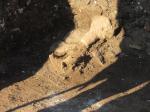Summary (English)
- Excavations in probes 11 and 12 explored the parts of the ramparts. The construction of the ramparts is the largest construction activity that has completely changed the city’s concept and life in it. For a long time it was considered that the rampart was simultaneous with monumental buildings of public character in the center of the city, or that its construction was bound for the end of the I / the beginning of the 2nd century. Last year’s research refuted these theses, but we determined only relative dates, while this year we confirmed the date of the first half of the 4th century when the city walls were erected. In front of the ramparts at the tower C there is a spacious plane above the Širalija stream, which was the reason for building a rectangular tower and digging the defensive trench in front of it. The tower is in the lower part of the building, using large stone blocks placed in three rows to be overwhelmed over them by the use of sewn stone and lime mortar. Unfortunately the foundations of the towers are underlined in this place by erosion and its SI corner is devastated by a shell from one of the World Wars. This sort of situation forced us to bring the destabilized foundations through the borders and clutter up and thus consolidate to the realization of its conservation. In the center of the ancient city, research was carried out in three places. Within 10 rooms there is a room known as a male termae. In the researches after the Second World War, a mosaic was discovered in this room, which was, unfortunately, completely destroyed and the only one left behind was the bordering the southern part of the room. However, the research has shown significant data regarding the relationship of a building with large topics. The building was built separately from the termae and it was not excluded that it did not have a bath function at all. Based on the findings of the museum from old research, the date of construction should probably be tied to the period of late antiquity. At object IX, the capitol temple of Doclea, was explored in two places in the atrium, where the older phases of the object from the 2nd century were registered. It consists of the remains of several rooms that were separated by partition walls. This building was destroyed in the fire and a temple was built on its site, using some of the older walls. The main street decumanus is cut between objects X and IX. Three phases of the street were discovered in the 4-mile long longitude of 15 m. The first street dating back to the 1st century was poured about half a meter late in the same century in order to build a new one. This phase corresponds to the construction and other facilities in the center when the city gets the status of the municipium. Then, for some reason, the street is shortened by 5 m. In the 4th century there is another rise in street level. However, this is only done with the accumulated land. In the south and southwestern parts of Doclea, they continued their studies in the same places where they started last year. From the north side of the decumanus street, the dimensions of the new facility numbered XVII are captured. This is a late antique villa urban, from which only one exedra room was explored last year, in fact a guest room with underfloor heating. Most of the building was devastated by the construction of a railway line, and the floor levels were largely destroyed. The probe 13 was reopened in the southern part of the city. It was confirmed only SI corner of the room which can be given in the third century according to the findings. Stratigraphic image in the probe is extremely simple, but for the first time in Doclea, at the level of the floor, the entire vessel is discovered. Although prematurely, for now, we assume that this is a residential area or part of insula. Another important discovery was revealed in the probe. This space was inhabited in prehistoric times. Namely, under the Roman layers and horizons, the finds of the town’s ceramics are most likely to be given during the Bronze Age. They are connected with the remains of semi-dyed houses whose walls were made of platelets and beautiful. Such settlements are extremely rare, which makes this data even more valuable.
e is no summary for this season.
- Miloš Živanović
Director
Team
- Dejan Drašković
- Ivana Medenica
- Nikola Borovinić
- Đuro Pribilović
- Vesna Popović
- Ksenija Đurišić
Research Body
- Center for Conservation and Archeology of Montenegro






![Download [PDF]](/excavation/skins/fasti/images/results/download_sml.png)

